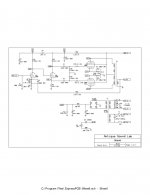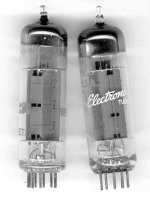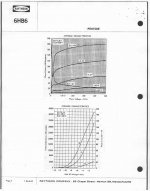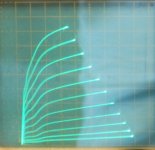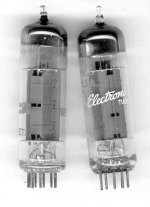Ok real newbie ere , don't know much about pentodes or Class AB1 but i'am willing to learn.
The is what i would like to achieve with this 6hb6
1] class AB1 pushpull or even class A depending on out wattage
2] Low distortion
3] and the best frequency response i can achieve
4] 12 to 15 watts OR more
5] some feed back
Ok these are my goals..
Bits i have to hand
5000k a-a HAMMOND 1654 OUTPUT TX 30WATT
300VDC REGULATED POWER SUPPLY
390VDC POWER SUPPLY NOT REGULATED
so this what i know about Class AB1 both tubes operate in class A at half primary a-a 2500k and 1 quarter in Class B.
current = 390/2500k=0.156 class A full voltage 390vdc
current = 390/1250k=0.312 class B at half voltage 195vdc
ok this is where my knowledge ends , so i hope i have not made a fool of myself.
cheers
Den
The is what i would like to achieve with this 6hb6
1] class AB1 pushpull or even class A depending on out wattage
2] Low distortion
3] and the best frequency response i can achieve
4] 12 to 15 watts OR more
5] some feed back
Ok these are my goals..
Bits i have to hand
5000k a-a HAMMOND 1654 OUTPUT TX 30WATT
300VDC REGULATED POWER SUPPLY
390VDC POWER SUPPLY NOT REGULATED
so this what i know about Class AB1 both tubes operate in class A at half primary a-a 2500k and 1 quarter in Class B.
current = 390/2500k=0.156 class A full voltage 390vdc
current = 390/1250k=0.312 class B at half voltage 195vdc
ok this is where my knowledge ends , so i hope i have not made a fool of myself.
cheers
Den
Last edited:
Here's the datasheet for that valve--
http://www.shinjo.info/frank/sheets/135/6/6HB6.pdf
Out of curiosity--Why choose an American valve--when you're in the UK. Have you a stash of some?
There's many similar TV Vertical Deflection European valves that are easy to get and dirt cheap--providing you dont mind using a different heater-voltage, you can use some very fine valves, probably better than the chosen one...
There's the PCL82, PCL86, PCL805--advantage of these--There's a triode in the same jar. For discrete pentode we got--, PL508, PL504, PL509 PL84, PL/EL83, PL/EL36, --generally all the 'P' series are dirt cheap--and good makes NOS.
http://www.shinjo.info/frank/sheets/135/6/6HB6.pdf
Out of curiosity--Why choose an American valve--when you're in the UK. Have you a stash of some?
There's many similar TV Vertical Deflection European valves that are easy to get and dirt cheap--providing you dont mind using a different heater-voltage, you can use some very fine valves, probably better than the chosen one...
There's the PCL82, PCL86, PCL805--advantage of these--There's a triode in the same jar. For discrete pentode we got--, PL508, PL504, PL509 PL84, PL/EL83, PL/EL36, --generally all the 'P' series are dirt cheap--and good makes NOS.
Last edited:
Yes got that already , been looking at for a few weeks now and i still none the wise, and it has not got any AB1 operating conditions .
cheers
Den
cheers
Den
They were 2 dollars when i brought them , and some of the lads on here were talking them up, so i got some.
now that i come to put this tube into action , it seems their is little or no info or circuit incorporating this valve ..
cheers
Den
now that i come to put this tube into action , it seems their is little or no info or circuit incorporating this valve ..
cheers
Den
I get the feeling this is for a guitar amp. Should that be the case, this thread needs to move to the Amps and Instruments "board".
The primary impedance of the Hammond 1654 is low for a PP pair. However, a parallel/push/pull (PPP) quad will work out nicely. Build a negative bias supply and use individual trim pots. for each of the 4 control grids. Get somebody to match the 6HB6s into quads.
Low distortion is a stated goal. Full pentode mode with regulated screen grid B+ does that, while protecting the somewhat fragile screen grids. Use the 300 V. supply for anode B+ and an additional Maida regulator for g2 B+ at 250 V.
The ASL AV-8 circuit (schematic uploaded) is (IMO) a reasonable point of departure, for this project. Look at the topology, not the parts values and voltage specifications. The 12AT7/ECC81 should nicely take care of triode requirements. BTW, the AV-8 uses self, AKA cathode, biased O/P tubes. That's OK for pairs, but PPP needs close control of each tube's "idle" current. A 10 Ω resistor between each cathode and ground provides the necessary test points.
The primary impedance of the Hammond 1654 is low for a PP pair. However, a parallel/push/pull (PPP) quad will work out nicely. Build a negative bias supply and use individual trim pots. for each of the 4 control grids. Get somebody to match the 6HB6s into quads.
Low distortion is a stated goal. Full pentode mode with regulated screen grid B+ does that, while protecting the somewhat fragile screen grids. Use the 300 V. supply for anode B+ and an additional Maida regulator for g2 B+ at 250 V.
The ASL AV-8 circuit (schematic uploaded) is (IMO) a reasonable point of departure, for this project. Look at the topology, not the parts values and voltage specifications. The 12AT7/ECC81 should nicely take care of triode requirements. BTW, the AV-8 uses self, AKA cathode, biased O/P tubes. That's OK for pairs, but PPP needs close control of each tube's "idle" current. A 10 Ω resistor between each cathode and ground provides the necessary test points.
Attachments
6HB6 looks just like a 6BQ5/EL84 with 2X the gm, so it only needs half the grid signal to drive it. Any EL84 amp design should work, with maybe an adjustment of the feedback level. Grid stoppers needed for sure.
Hi Eli Duttman
thanks for schematic , i will look into that idea yes somewhere to start, no not guitar amp.
@ smoking-amp what would be the max input to the grid , and how would i attenuate the AF signal from a drive if it is excessive
i will try grid bias for now about -14vrms
cheers
Den
thanks for schematic , i will look into that idea yes somewhere to start, no not guitar amp.
@ smoking-amp what would be the max input to the grid , and how would i attenuate the AF signal from a drive if it is excessive
i will try grid bias for now about -14vrms
cheers
Den
Last edited:
Here's the datasheet for that valve--
http://www.shinjo.info/frank/sheets/135/6/6HB6.pdf
Out of curiosity--Why choose an American valve--when you're in the UK. Have you a stash of some?
There's many similar TV Vertical Deflection European valves that are easy to get and dirt cheap--providing you dont mind using a different heater-voltage, you can use some very fine valves, probably better than the chosen one...
There's the PCL82, PCL86, PCL805--advantage of these--There's a triode in the same jar. For discrete pentode we got--, PL508, PL504, PL509 PL84, PL/EL83, PL/EL36, --generally all the 'P' series are dirt cheap--and good makes NOS.
Why U.S. valves? Curiosity indeed 😛
I just want to try this cousin of the EL84. Same screen grid spec (300V/2W) and more sensitive control grid, what's not to love?
Could be that since unknown US types are even more obscure over here, the prices are lower than euro types. Unfortunately the PL509/519 is far from cheap these days. 😡
There are still some very interesting cheap ones though. Just don't mention them here before you have stocked up a lifetime supply 😉
Plot the 6HB6 loadline for the B+/Vg2/Z_OT conditions. Peak grid signal needs to stay below the grid bias.
You could just use an EL84 design with a lower Mu input tube, or just settle for half the input signal for max output. (depends on what gets done with the feedback, left alone, the extra gm will just get turned into extra N Fdbk)
Another option would be to use up some of the extra 6HB6 gm with a Schade like plate to grid feedback. Just use Pete Millett's DCPP amplifier schematic. Should work great there. (keeping in mind the max B+ spec for the 6HB6)
You could just use an EL84 design with a lower Mu input tube, or just settle for half the input signal for max output. (depends on what gets done with the feedback, left alone, the extra gm will just get turned into extra N Fdbk)
Another option would be to use up some of the extra 6HB6 gm with a Schade like plate to grid feedback. Just use Pete Millett's DCPP amplifier schematic. Should work great there. (keeping in mind the max B+ spec for the 6HB6)
Last edited:
Keeping with the theme of doubled up gm, and using Jazbo's linked schematic, one could put a 6LQ8 in place of the 6JN8. (both cheap tubes) Should be quite linear with all the gm. Would have to check the microphonics of that front stage then.
Last edited:
Do you remember which brand of 6HB6 was used to produce the traces in this post? I tried building the pentode SPICE model based on the triode curves, but the result was not that close to the the GE datasheet.Should be quite linear with all the gm.
I traced several 6HA6's which is suppose to the same as 6HB6, and all of them had similar curves to the one that you posted, so at this point I have to conclude that the datasheets are somehow in-correct... Anyway, here is the plate characteristic with with 6k load line for your reference:
An externally hosted image should be here but it was not working when we last tested it.
Most of the 6HB6 tubes here are RCA and GE, with a few Motorola and Raytheon and Westinghouse. Many are marked 6HA6/6HB6. I put an RCA and a GE 6HB6 (not likely the exact same ones) on the tracer again, and it looks like the 1st trace below is the RCA and the 2nd is the GE. (10 mA/div Vert, 50 V/div Horiz.)
Although I had to turn the g2 up to 150 V or push the g1 span well positive to get the max current up to the full screen. While the data recorded for the original GE curve says 100V on g2. So either an error made before or there is some significant spread in the characteristics of these. ( sometimes used as V regulator tubes, although the GE datasheet says Vertical deflection and Video amp.)
If you are referring to the rounded curve knees versus squared ones. Most all of the tubes I have looked at are square knee. However, I do have some RCA ones labeled 6HA6/6HB6 that have a smaller plate structure and are clearly pentodes. They are marked "GT BRITAIN". These DO have rounded knees.
Pics attached of the tube types. Left is the pentode version from GB, right is the more typical beam pentode version.
http://frank.pocnet.net/sheets/135/6/6HB6.pdf
Although I had to turn the g2 up to 150 V or push the g1 span well positive to get the max current up to the full screen. While the data recorded for the original GE curve says 100V on g2. So either an error made before or there is some significant spread in the characteristics of these. ( sometimes used as V regulator tubes, although the GE datasheet says Vertical deflection and Video amp.)
If you are referring to the rounded curve knees versus squared ones. Most all of the tubes I have looked at are square knee. However, I do have some RCA ones labeled 6HA6/6HB6 that have a smaller plate structure and are clearly pentodes. They are marked "GT BRITAIN". These DO have rounded knees.
Pics attached of the tube types. Left is the pentode version from GB, right is the more typical beam pentode version.
http://frank.pocnet.net/sheets/135/6/6HB6.pdf
Attachments
Last edited:
Thanks, I have to run some more traces on mine, most of them are Raytheon's, did they buy out GE at one point?
I looked at the Westinghouse 6HB6 here and it is a true pentode also, and it looks exactly like the RCA made in GB tube, except it says made in Japan!
Looking at the Motorola and Zenith tubes, exactly the same as the GE and RCA beam pentode tubes. Although some RCA tubes do not have the two narrow windows in the edge end of the plate.
I think Raytheon eventually got out of the commercial tube line, mainly making military and radar tubes. So their later 6HB6 tubes may have been made by someone else. But Raytheon is registered as the design originator for the 6HB6 in 1961. They are also registered as the design originator of the 6HA6 in 1964. Somewhat odd that the up-rated tube came 1st.
Looking at the Motorola and Zenith tubes, exactly the same as the GE and RCA beam pentode tubes. Although some RCA tubes do not have the two narrow windows in the edge end of the plate.
I think Raytheon eventually got out of the commercial tube line, mainly making military and radar tubes. So their later 6HB6 tubes may have been made by someone else. But Raytheon is registered as the design originator for the 6HB6 in 1961. They are also registered as the design originator of the 6HA6 in 1964. Somewhat odd that the up-rated tube came 1st.
Here are the original Raytheon datasheets for the 6HB6 and 6HA6.
It says its a power pentode with a sharp g1 cutoff.
The later 6HA6 datasheet adds that it has a low plate knee. It also drops the plate dissipation to 8 Watts. Obviously the 6HB6 already did too, with 10 Watts diss.
So that's how the plate curves are SUPPOSED to look for 6HB6/6HA6. Looks like RCA or GE came out with a beam re-design later, but never registered it separately.
It says its a power pentode with a sharp g1 cutoff.
The later 6HA6 datasheet adds that it has a low plate knee. It also drops the plate dissipation to 8 Watts. Obviously the 6HB6 already did too, with 10 Watts diss.
So that's how the plate curves are SUPPOSED to look for 6HB6/6HA6. Looks like RCA or GE came out with a beam re-design later, but never registered it separately.
Attachments
Last edited:
Here are some plate curves for the RCA 6HB6 made in GB real pentode version. 10 mA/div Vert., 50 V/div Horiz., 170 Vg2
Doesn't look all that close to the Raytheon specs either. Good luck trying to get some matched tubes!
I just tried the Westinghouse real pentode version (made in Japan), and it has identical curves. Someone not telling the truth about mfg. origin.
Tube pics again. Left tube type (real pentode version) corresponds to the 1st curves shown. Right tube type (beam type) corresponds to the last curves shown.
Doesn't look all that close to the Raytheon specs either. Good luck trying to get some matched tubes!
I just tried the Westinghouse real pentode version (made in Japan), and it has identical curves. Someone not telling the truth about mfg. origin.
Tube pics again. Left tube type (real pentode version) corresponds to the 1st curves shown. Right tube type (beam type) corresponds to the last curves shown.
Attachments
Last edited:
Hmm, it seems that there are quite a few different versions made over the years, indeed finding matched pairs will be pretty tough - but probably no big deal for the guitar amp that I plan to build though - more mismatch, the better😀Tube pics again. Left tube type (real pentode version) corresponds to the 1st curves shown. Right tube type (beam type) corresponds to the last curves shown.
Last edited:
Are there any etched codes on the GB version?
If they are made by Phillips/Mullard these codes can be used to find their euro designation.
Didn't Philips work with Matsushita in Japanese valve production? That could explain the similar construction.
If they are made by Phillips/Mullard these codes can be used to find their euro designation.
Didn't Philips work with Matsushita in Japanese valve production? That could explain the similar construction.
- Status
- Not open for further replies.
- Home
- Amplifiers
- Tubes / Valves
- 6HB6 as finals
